|
Owens
Yacht Company in World War Two
Dundalk, MD
1932-1961
Sold to Brunswick
Corporation in 1961
This page updated
4-19-2022.
An American Auto
Industry in World War Two Special Edition
Owens Yacht was started in 1932 by John
Charles and Norman Owens in Baltimore, MD. In 1936 the company
purchased eight acres of land on Bear Creek in Dundalk, MD, and built a
state-of-the-art boat building plant on the site. The Owens
brothers studied the mass production techniques of the American Auto Industry
and applied them to boat building at Dundalk. In 1957 the company
switched from wood to fiberglass construction, and also developed a line
of marine V-8 engines. In 1961 Owens was purchased by Brunswick
Corporation.
Owens Yacht Company World War Two Products: The
company had $10,014,000 in major war contracts during the war.
$9,538,000 or 95.3% of the of the total was for the U.S. Navy. The
remaining $476,000 or 4.7% was for two U.S. Army contracts early in the
war. $7,136,000 or 71.2% was for landing craft and landing craft
LCVP.
Table 1 - Owens Yacht Company's
Major World War Two Contracts
The information below
comes from the "Alphabetical Listing of Major War Supply
Contracts, June 1940 through September 1945." This was
published by the Civilian Production Administration, Industrial
Statistics Division. This table added 4-19-2022. |
|
Product - Customer |
Contract Amount |
Contract Awarded
Date |
Completion
Date |
| Boats - Army |
$255,000 |
4-1941 |
10-1941 |
| Boats - Navy |
$337,000 |
1-1942 |
8-1942 |
| Boats Rescue
- Army |
$221,000 |
3-1942 |
10-1942 |
| Boats - Navy |
$1,898,000 |
4-1942 |
12-1942 |
| Landing Craft
- Navy |
$1,240,000 |
10-1942 |
11-1943 |
| Landing Craft
- Navy |
$1,180,000 |
4-1943 |
5-1944 |
| Landing Craft
- Navy |
$3,295,000 |
8-1943 |
6-1945 |
| Ship Parts -
Navy |
$67,000 |
9-1944 |
1-1945 |
|
Landing Craft LCVP - Navy |
$1,004,000 |
10-1944 |
6-1945 |
| Landing Craft
LCVP - Navy |
$417,000 |
12-1944 |
6-1945 |
| Ship
Machinery Pts - Navy |
$100,000 |
4-1945 |
7-1945 |
| Total |
$10,014,000 |
|
|
|
Table 2 -
Boats built by
Owens Yacht during World War Two |
| Designation
|
Number Built |
Customer |
Description |
Year |
Comments |
| P-25 to P-41 |
17 |
U.S. Army |
42-foot Rescue Boat |
Oct 1941 - Apr
1942 |
This was an Owens
design based on one of it's recreational boats. |
| P-190 to P-206 |
17 |
U.S. Army |
42-foot Rescue Boat |
Dec 1942 - Mar
1943 |
|
| J-672 to J-681 |
10 |
U.S. Army |
Patrol Boat |
Apr 1943 - Jun
1943 |
|
| LCP(L) |
575 estimated |
U.S. Navy |
Landing Craft |
1941-1945
|
Dates given is
the time period these types were built. |
| LCV |
575 estimated |
U.S. Navy |
Landing Craft |
1941-1943 |
Dates given is
the time period these types were built. |
| LCVP |
1,000 estimated |
U.S. Navy |
Landing Craft |
1942-1945 |
Dates given is
the time period these types were built. |
42-Foot Rescue Boat:
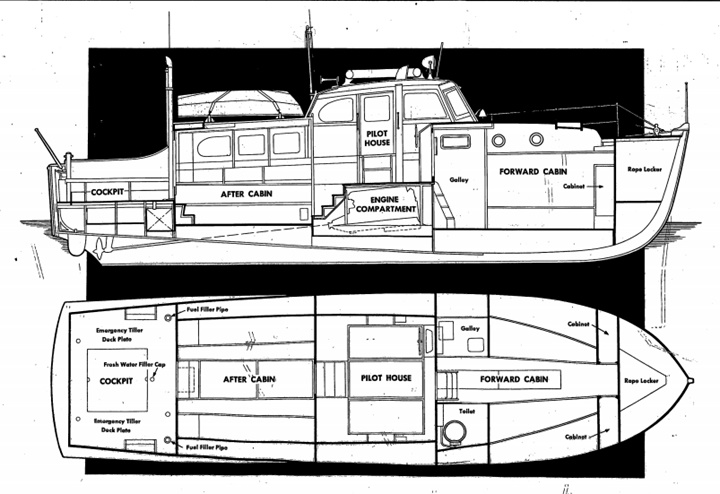
This and the next drawing show some of the
features of a 42-foot rescue boat that was based on an Owens
recreational boat. Drawing added 2-14-2020.
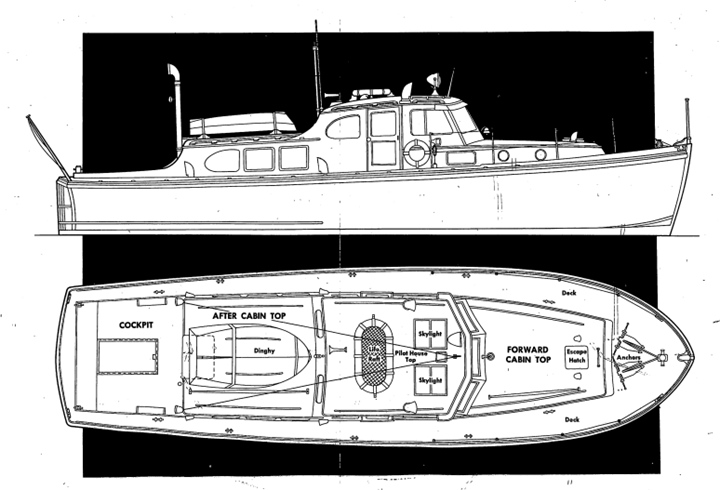
This type of boat was used for inland waterways
and close-to-shore rescues. Drawing added 2-14-2020.
Landing Craft, Personnel, Large (LCP(L)):
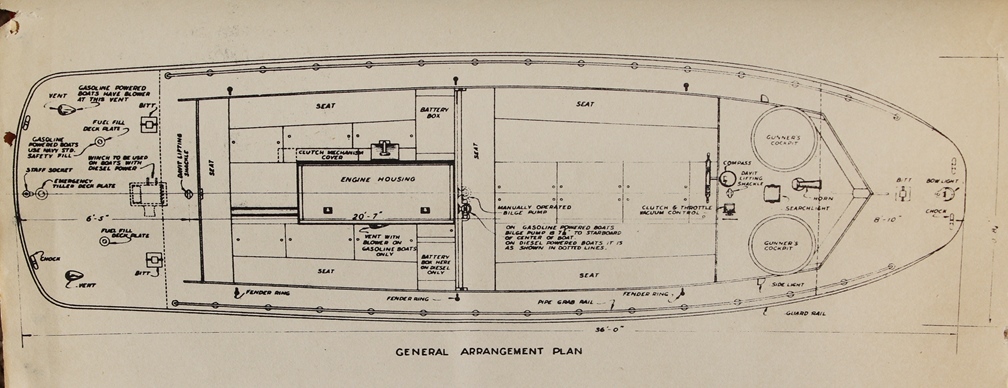
Owens built a number of LCP(L) landing
craft, the number of which is unknown due to lack of records. This
outline drawing and the one below are from the "Operators Manual,
36-foot "Eureka" Landing Motor Boats," revised June 1944 by Higgins
Industries. Owens and other manufacturers of the LCP(L) built them
from outline drawings like this along with a full set of details
drawings and parts lists. Drawing added 2-14-2020.
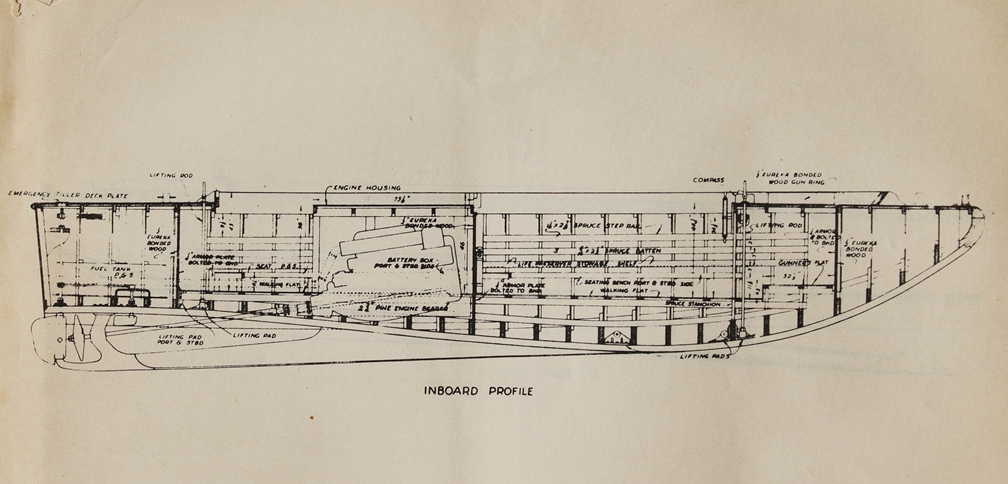
Drawing added 2-14-2020.
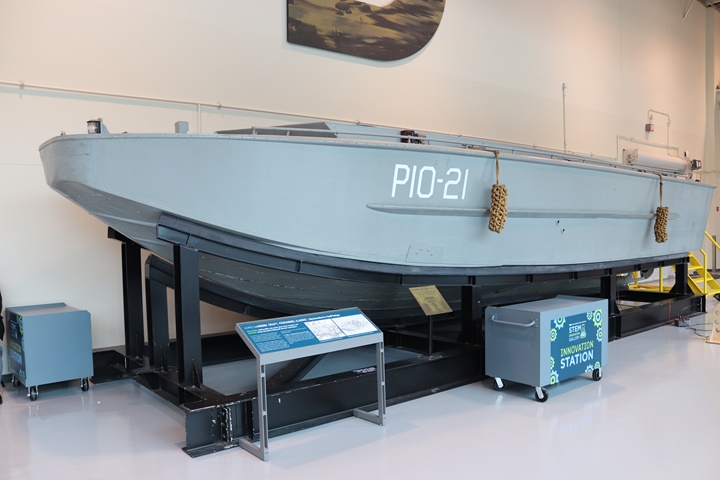
The final product looked like this, which is
a 1944 Higgins-built LCP(L). It is on display at the National
World War Two Museum in New Orleans, LA. Author's photo added
2-14-2020.
Landing Craft, Vehicle (LCV): The
LCV was the first ramped 36-foot landing craft designed and built by
Higgins Industries. It was the predecessor of the more well-known
LCVP or Higgins boat.
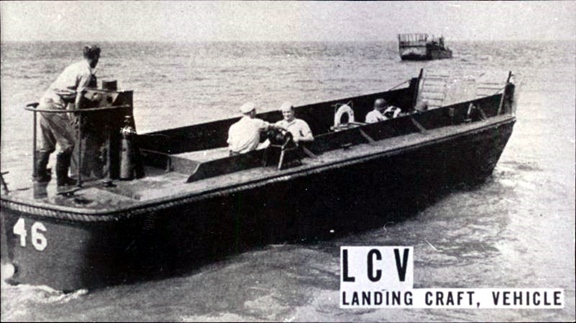
There were 2,633 LCVs built between 1941
and 1943 by Higgins Industries, Chris-Craft, Richardson, and Owens Yacht.
While not built in the
quantities of the LCVP, LCVs saw duty in early American invasions in
World War Two. It continued to be utilized even after the LCVP
became the dominant landing craft later in the war.
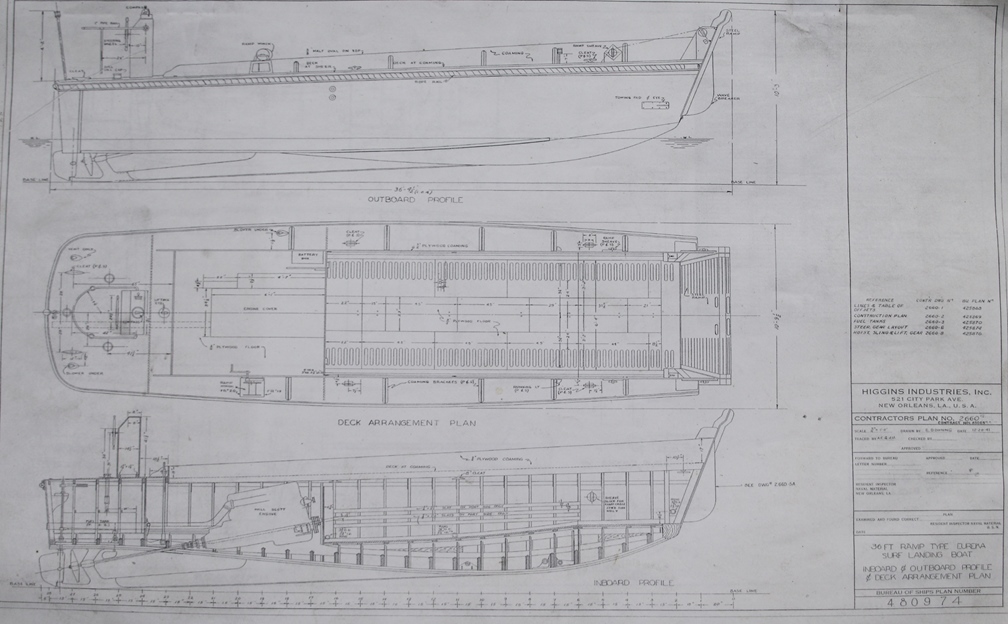
The name given to the LCV at the time of
this drawing on 12-29-1941 was 36 Foot Ramp Type Eureka Surf Landing
Boat. Owens Yacht would have used this outline drawing and the one
below along with a full set of detail drawings and a parts list to
build the LCV. Engineering drawing courtesy of C. Robert Gillmor added
1-9-2020.
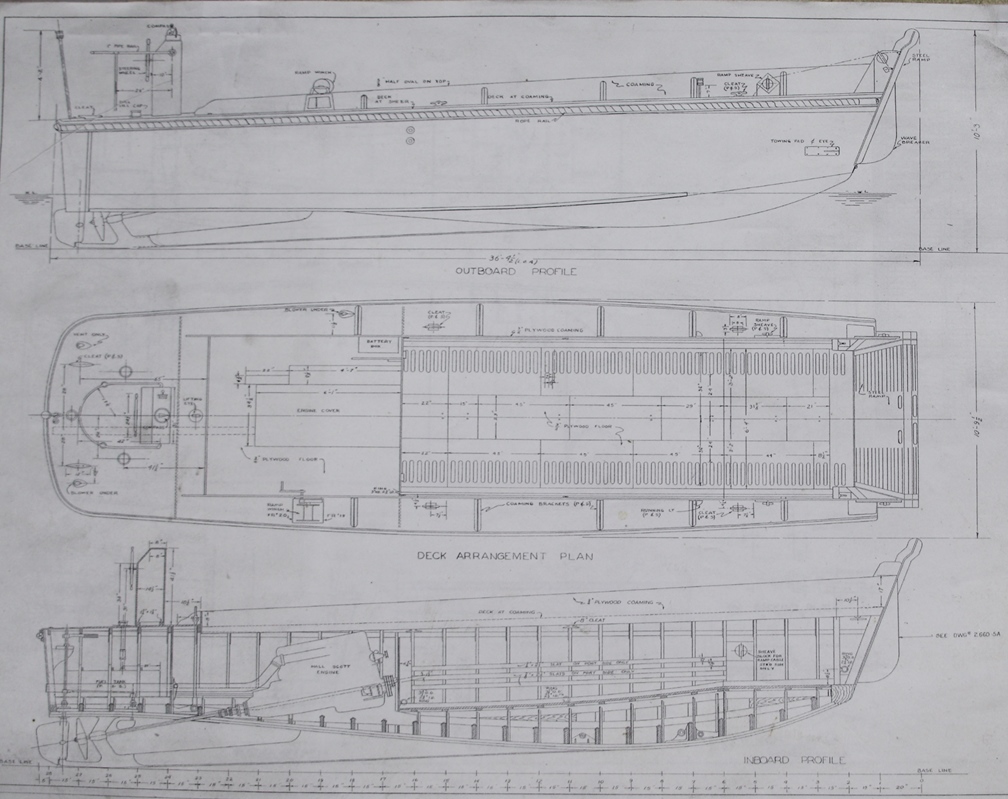
The length of the boat was 36 feet and
4-1/2 inches. It was 10 feet and 9 inches in height, and 10
feet and 9-1/2 inches wide. The engine shown is a Hall-Scott
168 Invader six-cylinder gasoline powered engine. Hudson Motor
Car Company supplied many of the Invader engines for this landing
craft. Other engines were installed in this boat depending on
availability. Engineering
drawing courtesy of C. Robert Gillmor added 1-9-2020.
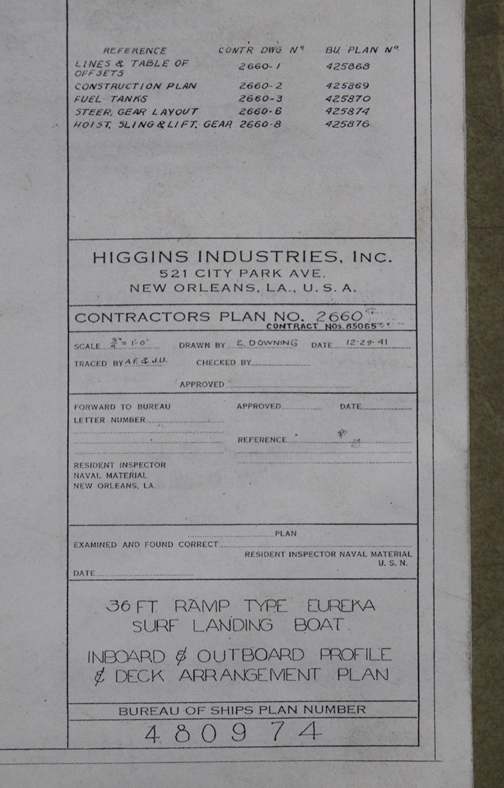
C. Downing drew this engineering drawing
of the 36 Foot Ramp Type Eureka Surf Landing Boat on 12-29-1941.
Note that it was neither checked nor approved. Engineering
drawing courtesy of C. Robert Gillmor added 1-9-2020.
Landing Craft, Vehicle, Personnel (LCVP):
"Yes Virginia, there is a Santa Claus."
From a poem by Francis Pharcellus Church in the September 21, 1897 in
the New York Sun. This was in reply to eight-year-old Virginia O'Hallon who
wrote a letter to the newspaper asking whether there really was a Santa
Claus.
Like the famous editorial reply by Francis Pharcellus
Church to Virginia O'Hallon in the September 21, 1897 New York Sun when
asked if there really was a Santa Claus...
"No Virginia, not every LCVP during
World War Two was built
by Higgins Industries."
The builders of the LCVPs
during World War Two need to be clarified, because when I go to museums
with WWII LCVPs and ask who built it, the answer is always "Higgins."
Then the docent will always add that Higgins built all the LCVPs of World War
Two. This is categorically incorrect. Higgins built only 52.8%
of the total LCVP production; and was one of
seven known companies that built the LCVP during the war.
Owens Yacht is one of six builders of the LCVP and built an estimated 1,000 LCVPs, or
4.2% of the total.
The Six Companies that built the LCVP during World War Two
I have had to do some best-guess estimating because the hard
data of who built exactly how many LCVPs does not exist or has
not yet been found. |
|
Company |
Number of LCVPs built |
Percentage of the total built |
Comments |
|
Chris-Craft, Algonac, MI |
8,602 |
36.8% |
This
is a derived valued based on various pieces of information found
in the literature. See my Chris-Craft page for the
calculations. |
| Dodge
Boat and Plane Corporation, Newport News, VA |
2,533 |
10.8% |
This
is number was published in the September 4, 1945 issue of the
Newport News, VA Daily Press. |
|
Higgins Industries, New Orleans, LA |
9,725 |
41.6% |
This
is a derived valued based on various pieces of information found
in the literature. See my Higgins Industries page for the
calculations. |
|
Matthews Company, Port Clinton, OH |
1,000 |
4.2% |
By
the end of the war, Matthews was producing two landing craft a
day or 730 boats per year. Over a three-and-a-half year period,
this would be 2,555 landing craft of all types. This is
the best estimate for this company at this time. I will
assume that 1,000 were LCVPs. |
| Owens
Yacht Company, Baltimore, MD |
1,000 |
4.2% |
Owens Yacht Company is credited with building a total of
2,150 LCP(L)s, LCVs and LCVPs. I will assume that 1,000
were LCVPs. |
|
Richardson Boat, North Tonawanda, NY |
500 |
2.1% |
Richardson Boat
Company is credited with building a total of ~1,000 LCP(L)s, LCVs
and LCVPs. This may also include LCMs built by the
company. I will assume that 500 were LCVPs. |
|
Total |
23,360 |
|
The
established number of LCVPs built during World War Two is
23,358. My estimate is surprisingly extremely close. |
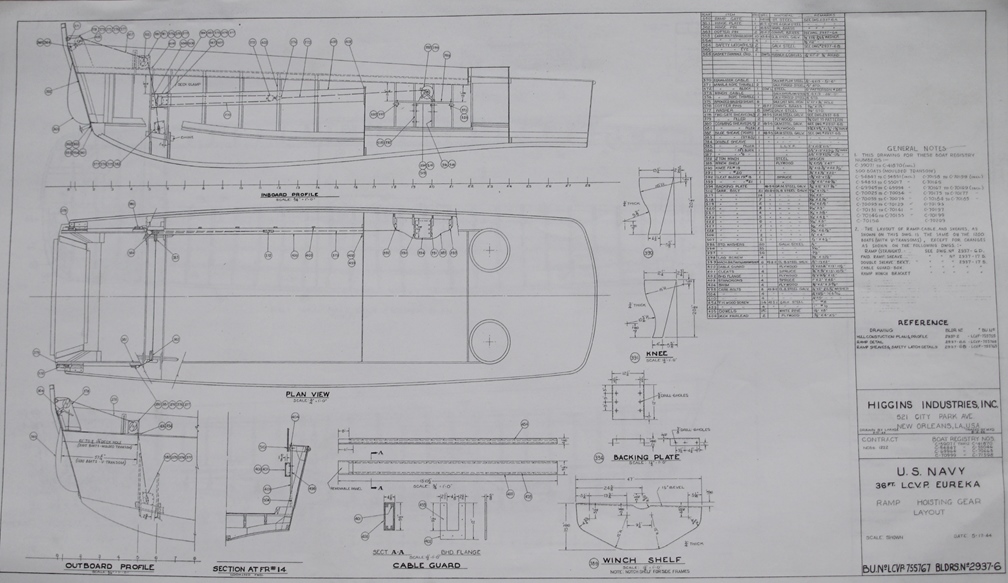
This ramp hoisting gear layout drawing gives
a general idea of the outline of the LCVP. Owens would have built
its share of the LCVPs from a full set of prints provided by Higgins
Industries. Engineering drawing courtesy of C. Robert
Gillmor added 1-9-2020.

The final product would look similar to
this, which is a replica built from Higgins engineering drawings just
like Owens used to build its portion of LCVPs during World War Two.
This replica is on display at the National World War Two Museum.
It is in the main lobby by the ticket booths. Author's photo added
2-14-2020.
|










